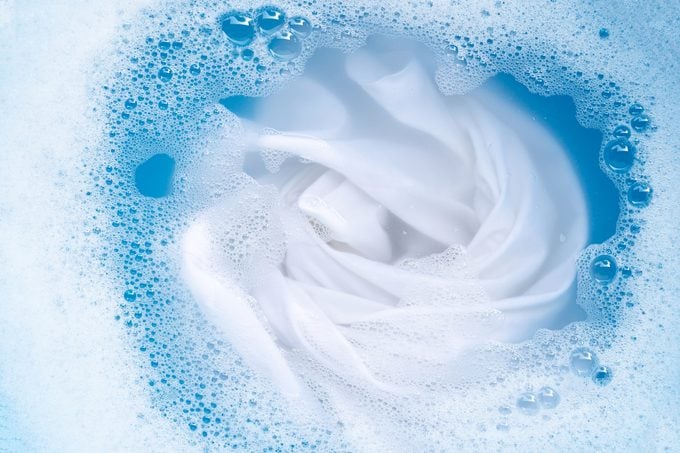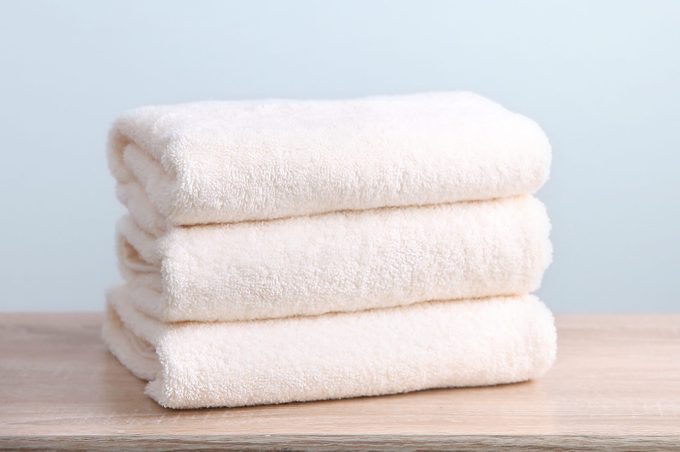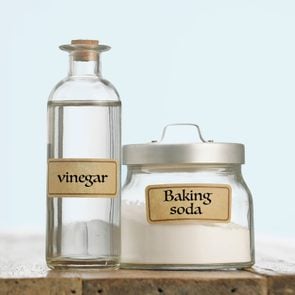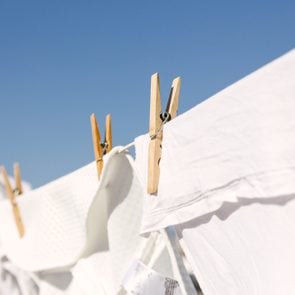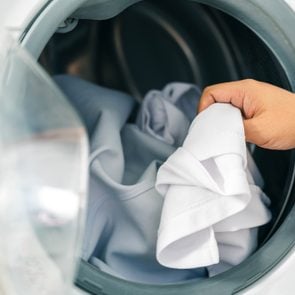How to Wash White Clothes to Keep Them Looking Bright
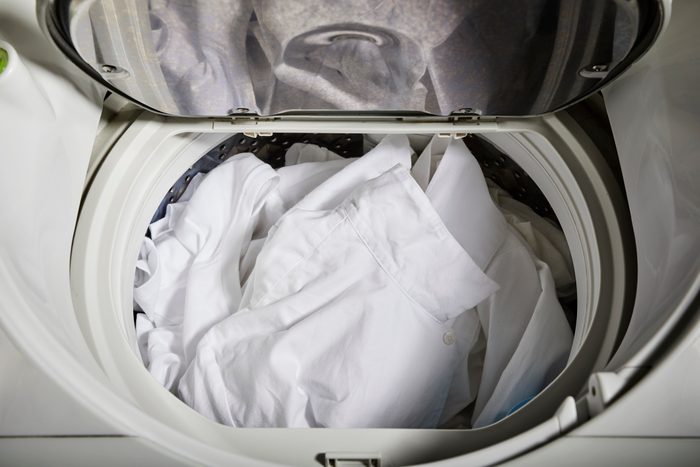
With a little care, your whites can stay bright, even as you enjoy your colorful life.
Our editors and experts handpick every product we feature. We may earn a commission from your purchases.
There’s nothing like a crisp, white dress shirt or new white T-shirt to make you stand a little taller. But let’s face it, keeping whites white can be challenging. Life happens, and suddenly you have to figure out how to get coffee stains out of clothes, how to remove sweat stains, and how to get red wine out of clothes. And the list goes on. But don’t worry. With the help of some top laundry experts, we’re going to answer all your questions about how to wash white clothes.
Before you load your washing machine, be sure to read your clothing’s care labels, paying special attention to the laundry symbols on the tags. From there, be sure you’re using the best laundry detergent for whites and are aware of what temperature to wash clothes.
Here’s how to do laundry so your white clothes look like you just bought them.
How to wash white clothes
Bright clothes can fade, but nothing irks quite like white laundry that’s taken on a yellowish tint. It’s a look that says your linens are old or you don’t know how to wash white clothes properly. Never fear. This step-by-step guide will get you well on your way to bright whites.
1. Read clothing labels
Whether you’re washing white clothes, linens, or delicates, it’s important that you read the care labels before doing anything. They’ll tell you exactly what you need to know to keep the item from getting damaged.
2. Sort your laundry
Knowing how to separate laundry will go a long way toward ensuring your white stay, well, white.
“It may seem antiquated, but it’s much safer to separate your whites from colored items, which could bleed in the wash and discolor them,” says celebrity stylist Samantha Brown.
You don’t need to separate laundry by fabric—except for bathing suits and high-performance athletic wear. Because they’re made of materials like spandex and nylon, those items need to be treated differently than cotton and linen and should be washed in their own load for the best results.
3. Pretreat stains
If you’re washing a white item that’s really dirty or has a stain on it, pretreat it before putting it in the machine. Brown recommends using OxiClean Max Force Foam Laundry Stain Remover or Grandma’s Secret Spot Remover Laundry Spray.
For getting whites their whitest, Annette Grant and Sarah Karakaian, professional short-term rental hosts and hosts of the Thanks for Visiting podcast, swear by Purex Fels-Naptha Laundry Bar & Stain Remover. “We dissolve one cup of Fels-Naptha in warm water and let our whites soak for an hour. We then proceed with our regular cleaning method.”
4. Pick the best detergent for white clothes
“We love Arm & Hammer Liquid Laundry Concentrate Plus OxicClean because it’s safe for both standard and high-efficiency washing machines,” says Grant. This means you don’t need to use a special HE detergent.
“We also add a cup of distilled white vinegar to the fabric softener compartment,” she says. “Distilled vinegar is a great whitening and brightening booster. Plus, it’s the best for combating odor. Make sure to use distilled white vinegar, as it doesn’t have any natural plant dyes that can stain your whites.”
5. Choose the right water temperature
It’s time to wash, but don’t just press start. You need to know whether you wash whites in hot or cold water.
“Hot water typically works best to eliminate dirt or stains, but it can also cause shrinkage, so it’s important to check the wash instructions on each item of clothing first,” says Drew Westervelt, founder and CEO of Hex Performance, which makes laundry detergent for activewear.
What temperature do you wash whites when the load includes patterns or stripes? It’s helpful to wash them in cold water the first few times to make sure the colors stay put. After that, a warm water wash should do the job.
6. Use a delicate cycle
Gentle, short cycles cause less abrasion to the fibers. So pop your whites in a load of like-colored delicates to keep them looking new.
7. Dry whites outside
“If you are serious about keeping your whites white, then the sun is your best friend,” says fashion stylist Leena Alsulaiman. “Whenever possible, line dry your whites and delicates. It helps preserve their colors and fiber integrity longer.”
8. Avoid fabric softener
Because residue buildup from fabric softener can create a gray tinge on white clothes, the experts recommend using baking soda and vinegar in the laundry instead.
9. Clean your washer
Although it seems counterintuitive, you have to clean your washing machine every once in a while to ensure it doesn’t make your clothes dirtier. An easy way to do this is by simply tossing an Affresh Washing Machine Cleaner tablet into your machine once a month.
How to bleach white clothes
The idea that bleach is the answer to dingy white clothes is, unfortunately, a misconception. Just because an item is white doesn’t mean it’s safe to clean with bleach. The care label on your garment will tell you if you can use bleach on it or not.
There are two types of bleach: chlorine bleach and oxygen bleach. While chlorine bleach is the stronger of the two, oxygen is the one that’s color-safe. Never use chlorine bleach on anything delicate because it can easily damage it.
Why you might want to skip bleach
“I am not a big advocate for bleaching whites,” admits Alsulaiman. “I would attempt to wash stained whites with a bleach-free detergent and a whitening laundry booster like Mrs. Stuart’s Bluing Agent or Tide Brights and Whites Rescue In-Wash Laundry Booster first. Chlorine bleach mixed with proteins actually causes a chemical reaction, turning them yellow. So any lingering sweat on your shirts, T-shirts, or bed sheets will, without a doubt, turn yellow.”
There are a number of ways that the bleach itself can cause yellowing. “You might be using bleach on garments that aren’t meant to be bleached, or you’re using too much bleach, or the rinsing is insufficient,” explains Karakaian. “Also, not all bleach brands are created equal. Many cheap brands skimp on ingredients and won’t protect your garments from discoloration. We don’t use bleach much anymore because we love OxyClean but, when we do, we stick to Clorox.”
In fact, bleach isn’t what gives brand-new clothes their white appearance. “When you buy new clothes, the reason they’re super white is because of an added extra blue dye,” says Alsulaiman. “So when you wash incorrectly with chlorine bleach, it leaches the blue color slowly, which causes the yellow tones to come through.”
Bleaching white shirts and other clothing
Here’s how to bleach white clothes, according to the experts:
- Read the care instructions on the garment’s label.
- Spot test the bleach on a small, hidden spot on the garment before using it.
- Pretreat garments and let them soak for an hour.
- Pour detergent into the proper compartment of your washing machine. Follow instructions on the label to measure out the right amount. “More detergent doesn’t mean cleaner or whiter clothes,” warns Grant.
- Add bleach to your machine’s timed bleach dispenser. Since each machine is different, check the manufacturer’s instructions for specifics.
If you’re bleaching white delicates by hand, follow the same first three steps. Then remove the item from the dirty water, refill the sink with clean water, add the oxygen bleach, and let the garment soak for 15 to 30 minutes.
How to care for white clothes
You know how to wash white clothes. That’s a good first step. But you also need to properly care for clothing in order to keep it looking its whitest. Here’s how.
Wash them often. “It’s helpful to wash your whites after every wear,” says Brown, “as stains can build up and darken over time.” She recommends spraying the collar and underarms of white shirts with OxiClean Max Force Foam Laundry Pre-Treater before throwing them in the hamper.
Treat stains immediately. The longer you leave a stain in white clothing, the harder it is to remove. Don’t wait.
Get the wrinkles out. White shirts look sharp when they’re pressed, especially with crisp collars and cuffs, but before ironing, check the care label for any special instructions. If the garment is safe to iron, Brown suggests using a very lightly dampened washcloth between it and the iron to help protect it from burning or getting discolored from a rusty plate.
Store white clothes properly. Make sure they’re clean and totally dry before storing them in a cool, dry space so they don’t mildew. That means no attics, basements, or garages. If you’re putting them away for a season, make sure you use polypropylene storage boxes. Regular plastic containers can trap contaminants that can cause whites to yellow.
How to care for white towels
“When I’m washing white towels, I like to add a half cup of baking soda to the wash with the bleach-free detergent,” says Alsulaiman. “It’s gentle and helps lift the dirt that can lead to discoloration. Once a month, I also add some bluing agent into the mix.”
Grant and Karakaian recommend using distilled white vinegar instead of bleach to keep white towels looking and feeling their best.
How to care for white sheets
“Remember that when it comes to sweat, just because you can’t see it doesn’t mean it isn’t there,” says Alsulaiman. “So wash your white sheets and pillowcases once a week to once every ten days, then line dry, if possible.”
Grant and Karakaian, who are constantly washing bedding for their short-term rentals and can’t afford to let it get dingy, say, “Our go-to is baking soda, Arm & Hammer Liquid Laundry Concentrate Plus OxiClean, and then distilled white vinegar added to the washing machine’s bleach compartment. Sheets and pillowcases come out bright, white, and so soft!”
How to whiten white clothes that have yellowed
According to Westervelt, white clothing turns yellow over time due to a combination of dirt, sweat, and chemicals from deodorant.
“OxyClean does the trick,” says Grant. “Per the product’s instructions, we make a solution that any yellowed fabrics can soak in for eight or more hours. We then wash the pretreated items as usual, adding distilled white vinegar, and voilà! Whites are white again.” Next, learn how to wash cashmere properly at home.
Sources:
- Leena Alsulaiman, fashion stylist, style consultant, and coach
- Samantha Brown, celebrity stylist
- Annette Grant and Sarah Karakaian, short-term rental managers and hosts of the podcast “Thanks for Visiting“
- Drew Westervelt, founder and CEO of HEX Performance

